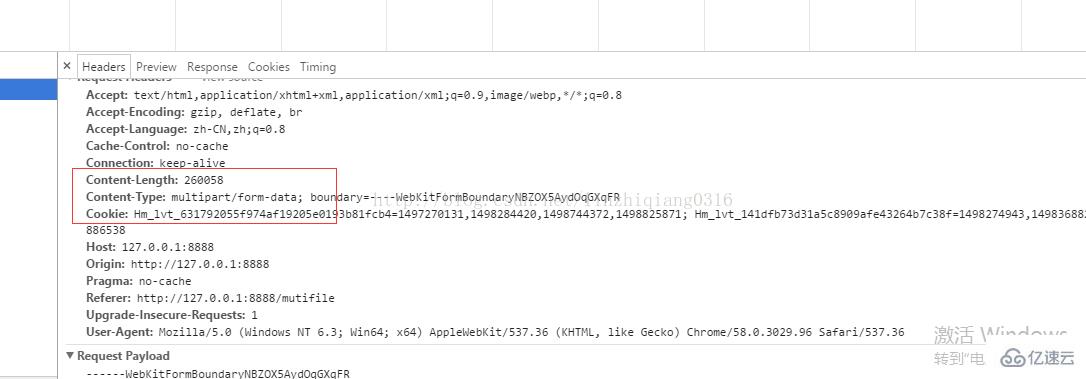您好,登錄后才能下訂單哦!
您好,登錄后才能下訂單哦!
這篇“如何用SpringBoot框架來接收multipart/form-data文件”文章的知識點大部分人都不太理解,所以小編給大家總結了以下內容,內容詳細,步驟清晰,具有一定的借鑒價值,希望大家閱讀完這篇文章能有所收獲,下面我們一起來看看這篇“如何用SpringBoot框架來接收multipart/form-data文件”文章吧。
現在很多文件上傳類型都是multipart/form-data類型的,HTTP請求如下所示:

可是問題就在于如果用傳統的Struts2或者servlet等都可以很容易的實現文件接收的功能,例如下面的代碼就可以實現:
boolean isMultipart = ServletFileUpload.isMultipartContent(request);//判斷是否是表單文件類型
DiskFileItemFactory factory = new DiskFileItemFactory();
ServletFileUpload sfu = new ServletFileUpload(factory);
List items = sfu.parseRequest(request);//從request得到所有上傳域的列表
for(Iterator iter = items.iterator();iter.hasNext();){
FileItem fileitem =(FileItem) iter.next();
if(!fileitem.isFormField()&&fileitem!=null){//判讀不是普通表單域即是file
System.out.println("name:"+fileitem.getName());
}
}可是今天我把這一段代碼放在SpringBoot上面的時候就怎么也接收不到文件信息了,一直以為是前端什么數據傳輸錯了。后來才知道原來SpringBoot有它自己的接收請求的代碼。下面就給大家詳細介紹一下它是如何實現這個功能的。
首選做一個簡單的案例,也就是單個文件上傳的案例。為了進行這個案例,首先需要建立一個SpringBoot框架
前臺HTML代碼:
<html> <body> <form action="/upload" method="POST" enctype="multipart/form-data"> <input type="file" name="file"/> <input type="submit" value="Upload"/> </form> </body> </html>

后臺接收代碼:
/**
* 文件上傳具體實現方法;
*
* @param file
* @return
*/
@RequestMapping("/upload")
@ResponseBody
public String handleFileUpload(@RequestParam("file") MultipartFile file) {
if (!file.isEmpty()) {
try {
/*
* 這段代碼執行完畢之后,圖片上傳到了工程的跟路徑; 大家自己擴散下思維,如果我們想把圖片上傳到
* d:/files大家是否能實現呢? 等等;
* 這里只是簡單一個例子,請自行參考,融入到實際中可能需要大家自己做一些思考,比如: 1、文件路徑; 2、文件名;
* 3、文件格式; 4、文件大小的限制;
*/
BufferedOutputStream out = new BufferedOutputStream(
new FileOutputStream(new File(
file.getOriginalFilename())));
System.out.println(file.getName());
out.write(file.getBytes());
out.flush();
out.close();
} catch (FileNotFoundException e) {
e.printStackTrace();
return "上傳失敗," + e.getMessage();
} catch (IOException e) {
e.printStackTrace();
return "上傳失敗," + e.getMessage();
}
return "上傳成功";
} else {
return "上傳失敗,因為文件是空的.";
}
}這樣便可以接收multipart/form-data類型的文件。接下來,我們來看一個上傳多個文件并且每個文件都有多個字段的案例。
前臺HTML界面:
<!DOCTYPE html> <html xmlns="http://www.w3.org/1999/xhtml" xmlns:th="http://www.thymeleaf.org" xmlns:sec="http://www.thymeleaf.org/thymeleaf-extras-springsecurity3"> <head> <title>Hello World!</title> </head> <body> <form method="POST" enctype="multipart/form-data" action="/batch/upload"> <p>文件1:<input type="text" name="id" /></p> <p>文件2:<input type="text" name="name" /></p> <p>文件3:<input type="file" name="file" /></p> <p><input type="submit" value="上傳" /></p> </form> </body> </html>

后臺接收代碼:
@RequestMapping(value = "/batch/upload", method = RequestMethod.POST)
@ResponseBody
public String handleFileUpload(HttpServletRequest request) {
MultipartHttpServletRequest params=((MultipartHttpServletRequest) request);
List<MultipartFile> files = ((MultipartHttpServletRequest) request)
.getFiles("file");
String name=params.getParameter("name");
System.out.println("name:"+name);
String id=params.getParameter("id");
System.out.println("id:"+id);
MultipartFile file = null;
BufferedOutputStream stream = null;
for (int i = 0; i < files.size(); ++i) {
file = files.get(i);
if (!file.isEmpty()) {
try {
byte[] bytes = file.getBytes();
stream = new BufferedOutputStream(new FileOutputStream(
new File(file.getOriginalFilename())));
stream.write(bytes);
stream.close();
} catch (Exception e) {
stream = null;
return "You failed to upload " + i + " => "
+ e.getMessage();
}
} else {
return "You failed to upload " + i
+ " because the file was empty.";
}
}
return "upload successful";
}這樣就可以實現對多個文件的接收了功能了。
SpringBoot還可以對接收文件的格式還有個數等等進行限制,我這里就不多說了,大家有興趣的可以自己去了解了解。
千萬要記住SpringBoot對multipart/form-data類型的文件接收和其它是不一樣的,大家以后遇到的時候要千萬小心,不要像我一樣一往無前的踩進去還傻傻的以為是前端的錯誤。
package cn.juhe.controller;
import net.sf.json.JSONObject;
import org.springframework.web.bind.annotation.PostMapping;
import org.springframework.web.bind.annotation.RequestParam;
import org.springframework.web.bind.annotation.RestController;
import org.springframework.web.multipart.MultipartFile;
import org.springframework.web.multipart.MultipartHttpServletRequest;
import javax.servlet.http.HttpServletRequest;
import java.io.BufferedOutputStream;
import java.io.File;
import java.io.FileOutputStream;
import java.io.IOException;
import java.util.Date;
import java.util.Iterator;
import java.util.List;
import java.util.Random;
@RestController
public class UploadTest {
/**
* 接受未知參數名的多個文件或者一個文件
*
* @param request 請求
* @return 返回
*/
@PostMapping("/upload")
public JSONObject handleFileUpload(HttpServletRequest request) {
Iterator<String> fileNames = ((MultipartHttpServletRequest) request).getFileNames();
JSONObject result = null;
while (fileNames.hasNext()) {
String next = fileNames.next();
MultipartFile file = ((MultipartHttpServletRequest) request).getFile(next);
System.out.println("file.getName():" + file.getName());
System.out.println("file.getOriginalFilename():" + file.getOriginalFilename());
String folder = "E:\\upload\\received\\";
String picName = new Date().getTime() + ".jpg";
File filelocal = new File(folder, picName);
result = new JSONObject();
result.put(picName, folder + picName);
try {
file.transferTo(filelocal);
} catch (IOException e) {
e.printStackTrace();
}
}
JSONObject jsonObject = new JSONObject();
jsonObject.put("error_code", 223805);
jsonObject.put("reason", "文件過大或上傳發生錯誤");
Random random = new Random();
if (random.nextInt(10) > 3) {
jsonObject.put("error_code", 0);
jsonObject.put("reason", "success");
jsonObject.put("result", result);
}
return jsonObject;
}
/**
* 知道參數名的文件上傳
*
* @param multipartFile 文件
* @return 返回
* @throws IOException
*/
@PostMapping("/uploadCommon")
//public JSONObject upload(MultipartFile multipartFile) throws IOException {
public JSONObject upload(@RequestParam("A") MultipartFile multipartFile) throws IOException {
String name = multipartFile.getName();//上傳文件的參數名
String originalFilename = multipartFile.getOriginalFilename();//上傳文件的文件路徑名
long size = multipartFile.getSize();//文件大小
String folder = "E:\\upload\\received\\";
String picName = new Date().getTime() + ".jpg";
File filelocal = new File(folder, picName);
multipartFile.transferTo(filelocal);
/* {
"reason": "success",
"result": {
"D": "/upload/order/files/2016/a72750ad-8950-4949-b04a-37e69aff0d23.jpg",
"A": "/upload/order/files/2016/6842811a-eb76-453b-a2f3-488e2bb4500e.jpg",
"B": "/upload/order/files/2016/ccc96347-3cb8-4e2e-99a3-0c697b57eb88.jpg",
"C": "/upload/order/files/2016/d470d533-a54b-406a-a0f9-bbf82c314755.jpg"
},
"error_code": 0
}*/
JSONObject jsonObject = new JSONObject();
jsonObject.put("error_code", 223805);
jsonObject.put("reason", "文件過大或上傳發生錯誤");
Random random = new Random();
if (random.nextInt(10) > 3) {
jsonObject.put("error_code", 0);
jsonObject.put("reason", "success");
JSONObject result = new JSONObject();
result.put(name, folder + picName);
jsonObject.put("result", result);
}
return jsonObject;
}
}以上就是關于“如何用SpringBoot框架來接收multipart/form-data文件”這篇文章的內容,相信大家都有了一定的了解,希望小編分享的內容對大家有幫助,若想了解更多相關的知識內容,請關注億速云行業資訊頻道。
免責聲明:本站發布的內容(圖片、視頻和文字)以原創、轉載和分享為主,文章觀點不代表本網站立場,如果涉及侵權請聯系站長郵箱:is@yisu.com進行舉報,并提供相關證據,一經查實,將立刻刪除涉嫌侵權內容。